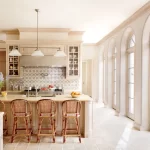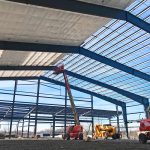Do you find the architecture of today’s cities fascinating? How exactly do architects plan and develop places of business like malls, offices, and hotels?
What are the goals, components, varieties, and merits of commercial architecture? This post is for you if you ever thought of becoming an architect or if you simply want to know more about the structures that surround us.
Table of Contents
What is the Purpose of Commercial Architecture?
Offices, stores, hotels, hospitals, and factories are just a few examples of the kind of buildings that fall under the responsibility of commercial architects. Studying the form and function of buildings is part of this field of study.
The purpose of commercial architecture is to create functional structures that are visually appealing while meeting specific business needs. A well-designed commercial building can attract more customers to businesses or provide a comfortable working environment for employees.
The commercial architect must consider various factors such as location, size requirements, zoning laws, safety regulations and building codes when designing these structures.
Efficient use of space within the building is essential because it helps businesses save on costs by reducing energy consumption and maximizing productivity.
Commercial architecture plays an integral part in shaping modern cities across the world by constructing sustainable infrastructure where people work or shop comfortably while providing a boost to local economies through job creation opportunities.
The Five Most Important Elements of Architecture
When designing a building, it is important to keep a few things in mind to ensure that the end result is both practical and aesthetically pleasing. Here are the five most important elements of commercial architecture:
1. Functionality: Commercial spaces need to be designed with functionality in mind. This means considering factors such as traffic flow, accessibility, and ease of use for employees and customers alike.
2. Aesthetics: While functionality is crucial, aesthetics cannot be overlooked when it comes to commercial architecture. An attractive building design can help draw in potential customers and create a positive first impression.
3. Sustainability: In today’s world, sustainability is becoming increasingly important in all aspects of design – including commercial architecture. Incorporating sustainable materials and energy-efficient systems can not only benefit the environment but also save on operational costs over time.
4. Flexibility: Commercial spaces often need to adapt to changing needs over time – whether due to growth or shifts in industry trends. Designing with flexibility in mind can help ensure that a space remains relevant and useful for years to come.
5. Brand Identity: It’s important for commercial buildings to reflect the brand identity of the business they house – whether through signage, color schemes or architectural features that tie into branding efforts.
Different Types of Commercial Architecture
The scope of commercial architecture extends much beyond conventional office buildings. Knowing the distinctions between the various types is crucial because each has certain needs and traits. The following are examples of some of the most typical commercial building designs.
The scope of commercial architecture extends much beyond conventional office buildings. Knowing the distinctions between the various types is crucial because each has certain needs and traits. The following are examples of some of the most typical commercial building designs.
We can say that the few types of commercial architecture are as instantly recognizable as office buildings. They can be any size from small businesses to multinational conglomerates, and they all use open floor plans to maximize productivity.
In addition, retail spaces include places to shop including grocery stores, shopping malls, and individual stores. Along with being practical for workers, the layout and design of these areas must take into account how customers will use them.
Also, establishments in the hospitality industry like hotels and restaurants aim to provide pleasant stays for visitors while also being practical enough to allow employees to do their jobs effectively.
Space in manufacturing facilities and storage facilities, for example, tends to be allocated not for aesthetics but for the needs of the workers and the machines they house.
Appreciating the range of possibilities in commercial design requires an understanding of these diverse types. When creating a building, architects must take into account a wide range of requirements and preferences from their clients.
There are good things and bad things about commercial design. On the one hand, it can give businesses a place that is unique and impressive, which fits with their brand and brings in customers. On the other hand, designing and building a commercial building that meets all the code standards can be expensive.
Conclusion
Commercial architecture is an essential aspect of modern society. It plays a vital role in shaping the way people interact with their surroundings and provides businesses with spaces that are both functional and visually appealing.
From office buildings to shopping centers, architects must consider various factors when designing these structures.









